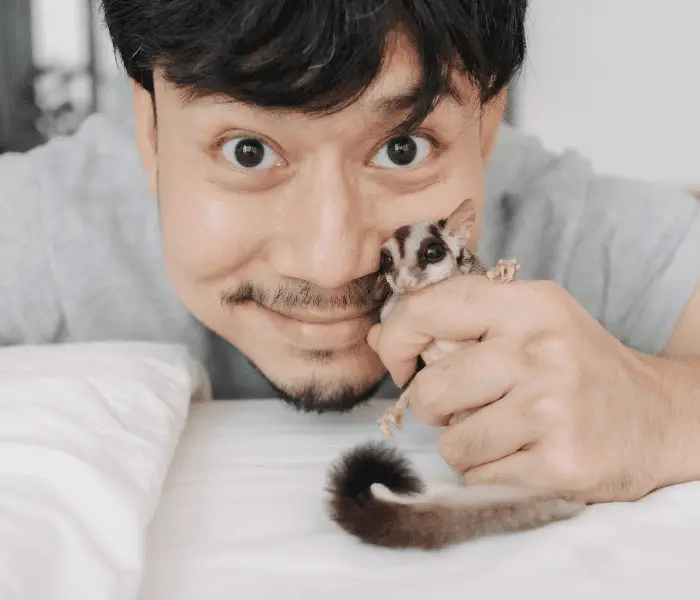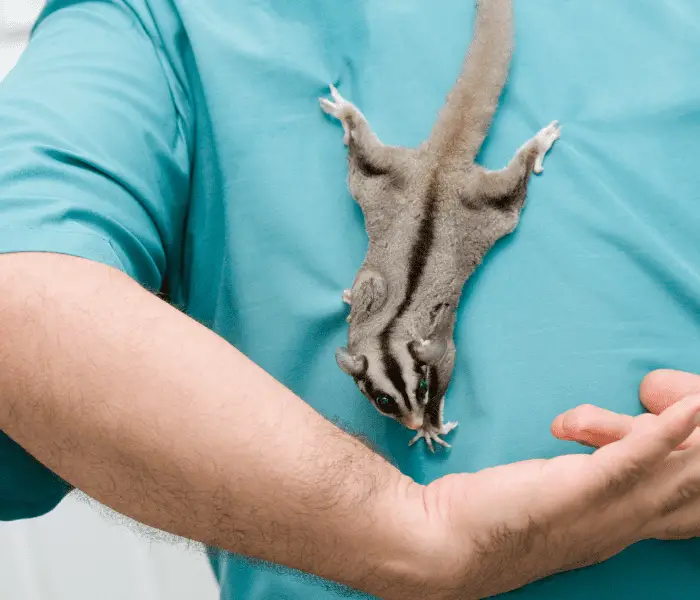This article contains affiliate links, and we may earn a commission at no cost to you if you choose to purchase through these links. I never recommend products that I do not trust or will not advise my veterinary clients and patients to use.
Sugar gliders can be very affectionate pets, but unfortunately, their jungle manners can be an obstacle. This article contains a few helpful tips on managing this behavior so that your sugar glider’s toilet habits do not stand in the way of vital sugar glider-bonding time.

Why Do Sugar Gliders Pee And Poop Everywhere?
Sugar gliders will urinate and defecate nearly everywhere. This is because sugar gliders do not have voluntary control of their elimination behavior like dogs, cats, and humans do. In addition, sugar gliders will frequently urine mark their territory.
Sugar gliders don’t have the same bowel and bladder control mechanisms as humans. The nerves that control the muscles that prevent us from going whenever we feel the urge are voluntarily controlled, meaning that your brain needs to send a signal to those muscles on a conscious level to relax when you go. Dogs and cats are similar to humans in this regard.
In contrast, cattle, and sheep, for example, have similar bowel and bladder control to sugar gliders. They can not voluntarily control the muscles that stop urination and defecation and, therefore, will eliminate whenever and wherever they feel the urge to.
Can A Sugar Glider Be Potty/Litter Trained?
Sugar gliders can not be successfully litter trained. This is because they do not have voluntary control over their elimination behavior. Sugar gliders are also not inclined to use a designated ‘toilet area’ and are unlikely to use a litter box.
Sugar glider owners who have claimed to litter train their sugar gliders have usually learned to recognize the times or signs that their gliders want to eliminate and then quickly place them in an appropriate spot or litter area.
A routine may be established to make unwanted toilet manners less likely with time and patience. You can actually say that it is the sugar glider owner rather than the glider themselves who have been litter trained!
Why Can Other Exotic Pets Be Litter Trained But Not Sugar Gliders?
Most exotic pet species such as bunnies or hamsters instinctively tend to use a designated area for elimination – a ‘toilet area’. We can leverage this behavior to teach them to use a litter box to pee and poop in, though never to the same level of success we see when litter training cats.
On the other hand, Sugar gliders do not use a designated elimination area. Because they live in trees in the wild, their feces will drop to the ground, and they, therefore, do not need to be concerned about soiling their environment.
5 Steps To Help Prevent Your Sugar Glider From Peeing And Pooping On you:
1. Leave Them For A Few Minutes After Waking Them Up
Sugar gliders will often pee and poop shortly after waking up. To avoid your sugar glider peeing and pooping on you soon after you take them out of their pouch, leave them in their cage for about 30 minutes after waking them in the afternoon to give them some time to do their business.
2. Leave Them In The Cage After Eating
Sugar gliders will often pee and poop shortly after eating. Feed their main meal in their cage and allow for some time for them to finish eating, pee and poop before handling them.
If you offer treats during playtime before they have a ‘meal,’ they may also be more inclined to pee and poop, so if you find that this is the case, rather avoid feeding too many treats during playtime.
3. Check Their Body Language For Signs That They Want To Go
The more time you spend with your sugar gliders, the more you will be able to recognize behavior associated with elimination. For example, if you have a highly active sugar glider, you might notice that every time they sit still for a short period of time, it may be because they want to go.
Sugar gliders tend to crouch down slightly and lift their hindquarters and tail before defecating – this is your cue to grab a tissue!
4. Stimulate Them To Go
Female sugar gliders will lick their joeys perineal area (under the tail) to stimulate elimination. This trick still applies to young gliders. You can use a wet wipe or damp cotton ball to rub their perineal area to encourage them to pee and poop.
You can use something similar to these doggy face wipes that are just the right size for the job and won’t cause any skin irritation.
This trick does not seem to work all that well for older gliders unless their owner regularly stimulates elimination throughout their lives.
5. Establish A Routine
By implementing the steps above, you can establish a routine to reduce the pee and poop you need to clean up when playing with your gliders.
A practical way to implement this would be to feed your gliders their main meal in the afternoon/evening and allow them around 45 minutes to an hour to eat and eliminate before taking them out. You can then stimulate them using a wet wipe or cotton ball to ensure they have done their business.
Being consistent with this routine may help your gliders finish all their toilet business before handling them.
How Can I Stop My Sugar Glider From Urine Marking Everywhere?
Sugar gliders will mark their territory using scent glands and urine. Both male and female sugar gliders will urine mark.
Unneutered males will urine mark more than neutered males; however, neutering will not eliminate this behavior entirely. Males will also scent mark more often when there is a female in heat nearby.
Females will urine mark more when they are in heat (you can read more about the cycle of female sugar gliders here). Sterilization of female sugar gliders is not routinely done as it is a higher risk and complicated surgery.
Unfortunately, scent-marking can not be eliminated, but neutering your male sugar glider may help. You can also be prepared for more urine marking when your female sugar glider is in heat by wearing old clothes or covering surfaces that you do not want your gliders to urine mark.

Can I Put A Diaper On My Sugar Glider?
It is not recommended to put a diaper on your sugar glider. Diapers severely restrict motion—a limited ability to jump and cause stress to a small exotic prey species like a sugar glider.
Instead, take precautions such as allowing them to play in an area where you can easily clean urine and feces up – I know some sugar gliders who will only play with their gliders in the bathroom.
Remember that they did not ask to be pets. Instead, we forced them into that role; we, therefore, need to make sure that we provide them with an environment where they are free to express natural and instinctive behavior.
Why Is My Sugar Glider Leaking Urine?
Constantly urinating small amounts may indicate urinary tract disease. It is recommended to take your sugar glider to the vet as soon as you notice this change in urinating behavior.
Why Is My Sugar Glider Vocalizing When Urinating?
Vocalization during urination is a common symptom of urinary tract infection in sugar gliders. Therefore, you should take your sugar glider to an exotics vet to have them examined and get appropriate treatment.
Conclusion
Peeing and pooping is, unfortunately, something all sugar glider owners need to be prepared to deal with. Hopefully, the tips in this article can help you find ways to make this less of an issue for you and your sugar gliders so that you will be able to spend more time bonding with you sugar gliders.
Resources
- Banks, R., 2013. Exotic small mammal care and husbandry. Hoboken: John Wiley, pp. 157 – 168. https://onlinelibrary.wiley.com/doi/book/10.1002/9781119265405
- Dierenfeld, E., 2009. Feeding Behavior and Nutrition of the Sugar Glider (Petaurus breviceps). Veterinary Clinics of North America: Exotic Animal Practice, 12(2), pp.209-215.
- Hillman, Elisa, “SUGAR GLIDER (PETAURUS BREVICEPS) BEHAVIOR IN RED VS BLUE LIGHTING” (2021). Honors Thesis. 127. https://red.library.usd.edu/honors-thesis/127
- Meredith, A. and Redrobe, S., 2002. BSAVA manual of exotic pets. 4th ed. Quedgeley: British Small Animal Veterinary Association, pp. 102 – 106 25. https://www.researchgate.net/publication/240493099_The_BSAVA_Manual_of_Exotic_Pets_4th_edn
- Saunders, R. (2015, April). What is a sugar glider and how do I nurse it?. In BSAVA Congress Proceedings 2015 (pp. 372-373). BSAVA Library.
- Suckling G. C. (1984) Population Ecology of the Sugar Glider, Petaurus breviceps, in a System of Fragmented Habitats. Wildlife Research 11, 49-75. https://doi.org/10.1071/WR9840049
